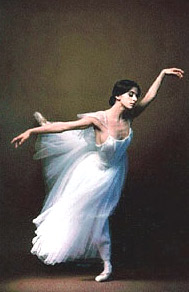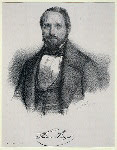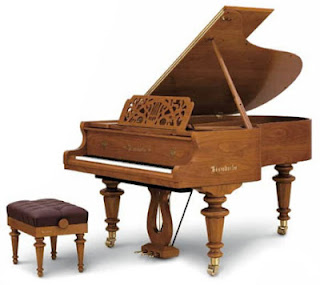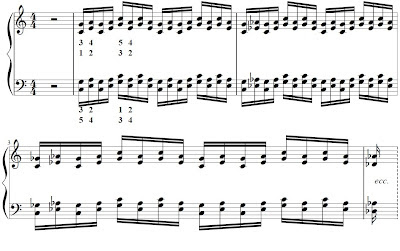The piano technique, aimed to the well-being of the person who plays, must be set as low as a condition of muscle relaxation. The vertical and lateral movements of the wrist help to achieve this objective of relaxation.
The video, performed personally by the author, illustrates clearly the correct execution of movements and positions.
In Exercise 2, in particular, we note that it is useful to perform a vertical movement of the wrist to support the weight of the arm on the first sound of each formula, the sounds after the wrist gradually gets up and runs even small lateral movements, orienting the hand to the thumb or toward the little finger, so that each finger is perpendicular to its key in the moment in which it must act.
The mode of attack is defined as a "legato sciolto" (tied loose) meaning an attack that binds the sounds one another, but of more concern agility of the fingers of the absolute continuity of the legato.
The complete set of 42 progressive esercises of piano technique describes each of the fundamental techniques to learn to play the piano properly, relaxed, aimed at well-being.
Satisfy your need for actively making music, learning to play a keyboard instrument and sing with your voice, to enhance the welfare of your person.
sabato 27 ottobre 2012
martedì 9 ottobre 2012
The rhythm and the body
 |
Adults can also take an immediate perception of rhythmic structures, from simple regularity of the pulse and its possible organization in binary form (a strong accent, a weak one) or ternary (a strong accent, two weak). The regularity of the pulse of the wrist is always cited as the first form of rhythmic experience that can be felt by every human being.
Breathing in its binary alternation of inspiration and expiration, is the physiological context in which it can be easily experienced a simple process of regular rhythmic organization.
Any other experience of the body, from walking to the alternation in the movement of the arms, can be used for the detection of a rhythmic structure elementary.
From this it can develop all kinds of complex skill, and already the ternary structure may seem more difficult (this happens to a lot of music students!), but the limits of learning ability can never be defined in a rigid way.
The classic method of Beyer
 One of the most classical piano studies is that of Ferdinand Beyer (1803-63). It is a classic German method, on which are formed many pianists of various generations.
One of the most classical piano studies is that of Ferdinand Beyer (1803-63). It is a classic German method, on which are formed many pianists of various generations.
In recent years, in particular for children, has been somewhat abandoned in favor of other publications, most appealing in writing music and images supplied.
However, it seems to me that the development of this area, as set by Beyer, is very effective for the progression of difficulty, is about learning to read music, both on the instrumental technique. What matters is the way you use a text: for example, I am using it by placing his pieces in a teaching methodology that emphasizes the rhythm, vocality and instrumental gestures, to the wellbeing of the person in the act of playing and, more generally, of making music.
In the original German some pieces are different, compared to the Italian editions: it is Volkslieder Germans really very nice.
mercoledì 3 ottobre 2012
The study of double notes on the piano
The technique of double notes is the most complex mechanisms executing piano. It is playing successions of two simultaneous sounds with the same hand, often at high speed. For example (Chopin, Study for the thirds, op. 25 n. 6):
The technique of double notes requires a synthesis of all the movements of the mechanism piano: the support of the weight of the arm, the articulation of the fingers, the lateral movement of the hand in relation to the perpendicular of the finger in use. You should also check the relaxation of the arm, forearm and hand, even by small movements of the wrist, elbow and shoulder. At this level of study you must have already acquired sensory awareness of the movements, positions and strategies to prevent stiffening.
To achieve this complexity of goals, in my collection 42 progressive exercises for piano Technique (The technique for the welfare of the pianist) I develop the material in ten exercises, which are precisely designed to progressively lead to the solution of the difficulty.
First we deal with the movement of articulation of the fingers, which represents an improvement to a technique already acquired in the first section of the method.
Then we proceed to the study of double notes, especially the sequences of the thirds and sixths, but also of the fourths and fifths (although less common in the classical repertoire).
A particular attention is then given to the finger passing over on other fingers, similar to what has been studied with the thumb to the study of the scales, but here extended to other fingers, for example: the fourth, third, second finger pass over the fifth, or the fifth passes under the fourth, third, second.
It then proceeds with the study of scales in double notes, and finally an exercise summary, which summarizes not only the technique of double notes, but in the end all the main movements of the piano mechanism:
sabato 22 settembre 2012
42 progressive exercises to piano technique
Over thirty years of experience in teaching piano
The 42 exercises of piano technique have been designed by me about thirty years ago. After obtaining my diploma in piano at the Conservatory of Milan in 1980, I started to practice the activity of pianist and at the same time I devoted to teaching.
Very soon I developed my concept of teaching, which has produced, among other things, a careful reflection on the mechanisms of execution at the piano, including through a careful reading of the most important texts written on the subject in the history of the teaching of the instrument.
Liberating education for the wellbeing of the person
The aspect that I immediately considered fundamental in the study of the instrument, is the conjunction of targets for the education liberating the body, emotion, intellect and spirituality in a holistic vision that involves the coordinated sharing of all human faculties and therefore excludes the separation of the individual elements.
In these exercises we face mainly the aspect of correct movements and positions useful to an instrumental mechanism that takes into account this fundamental requirement of well-being of the instrumentalist.
 Learning to play the piano in 42 exercises
Learning to play the piano in 42 exercises
The text aims to summarize all the main aspects of the piano mechanism, dividing them into 42 exercises. The material is divided into 10 sections, which deal with the various difficulties a sequential order.
Each card includes information on Mode of study, the various Formulas of the exercise, the description of the Movements to be performed and Development for the exercise, that is, all variants of the interplay of the keys and their fingerings.
The videos that accompany each lesson exemplify the execution of each exercise. Performed personally by the author, is to provide an immediate view of the correct understanding of movements and positions.
The subdivision of exercises following a specific criterion of progression of difficulty, which becomes clear in the text, so it is advisable to follow the order proposed.
The text is available on the website at this link. In Italian and in English
mercoledì 19 settembre 2012
The musical form in the theme of the Sonata K 331 by Mozart
A small musical analysis, useful to understand the music and play the piano well
In the form "Theme and Variations", the theme is a short piece done, we can call "song form" (or, in German, Liedform), the song form can be a binary form or ternary form.
The song form simplest is usually a binary form, in sixteen bars, which can be divided into two periods of eight bars each and every one of them can be divided into two phrases of four bars each. Therefore: (4 +4) + (4 +4) = 16.
In the analysis of the melody we can see striking similarities between the phrases: the second phrase can be so similar to the first, if we call 'a1' the first, the second can be called 'a2', and with this series 'a1' + 'a2' (4 +4) is complete for the period, which is usually defined by the repeat sign.
In the second period, the third phrase is often a little contrasting (we will call therefore the 'b'), while the fourth usually shows the state of the first or, more often, of the second, so 'a2'.
The binary form is thus characterized often (not always!) by the sequence 'a1-a2-b-a2'.
Another thing is the ternary song form, in which we recognize three periods (eg 8 +8 +8 = 24 bars).
But that is not the case in our Sonata K 331.
Compare with literary forms
We understood from this brief description that the music, especially in the "classic" style, follows its own rules and formal structures, neither more nor less than what happens in literary forms.The theme of the Sonata K 331
Now back to our K331 theme: we notice that bars 1-4 are the phrase 'a1', bars 5-8 are the phrase 'a2' (almost equal to the first, just change the cadence), and both are the first period. Then the bars 9-12 constitute a situation a bit different ('b', but we could also say 'a3', noting the melodic structure very similar) and then bars 13-16 represent the recapitulation of 'a2'. Happening here is the surprise: we find two additional bars (17-18), added at the bottom of the form.Freedom and the rule in the art of music
The question now is: why Mozart wrote a a binary song-form and therefore adds two bars and makes it 18 instead of 16? The answer is all too simple: why is Mozart! Or rather, because the rules of composition are never rigid constraints facing the objective of artistic creativity that is always played on the dialectic between rules and freedom.giovedì 13 settembre 2012
Playing the piano and singing into adulthood
Music in all stages of life
In many years of work I have experienced that you can learn to play the piano and sing in all stages of life, without effort, but rather to the great amusement and especially great wellness for your body and the whole person.
So, you can begin in adulthood! Many people are now convinced of what I'm saying, but unfortunately this way of teaching is not yet widespread.
I happened recently to post on a international social network, widely used in the world, a very simple question: "It 's possible to start learning piano as an adult?".
I received a flood of responses! I sparked a major debate.
And, amazingly, I noticed that most of the answers in the affirmative: yes, you can learn to play the piano and sing into adulthood.
Play the piano and sing: courage, you can!
Enough so with fear! Enough with the awe of the music! No more frustration!
Free your body, your emotions, your inner experience!
giovedì 6 settembre 2012
A Scherzo of Beethoven
A question from a student
I received this question from a student: "I have to analyze the Symphony No. 1 in C major by Beethoven op.21, but I have a problem with the minuet, which is the third movement. Scheme looks completely different from the other movements, but can not find anything on the internet, except that it is more a scherzo than a minuet, but not knowing what is a scherzo ... even the key changes are sudden and often do not understand anything .... ".Beethoven ends with the hedonism of the eighteenth century
Here's my answer. You are right, dear student: Menuetto is indicated (ie Minuetto), but in fact is a Scherzo, because it is a ternary time much faster, and this is one of the new structural of Beethoven Symphonies with respect to the eighteenth century. In fact, it beats one, namely: the movements for each measure are three, but the speed of the piece leads to only one scan for each beat.While prevalent in the eighteenth century idea of music entertainment and dancing minuet, with its moderate path and mannered gestures and gallant was almost the symbol of that type of music (and the society that demanded), with Beethoven states peremptorily bourgeois individualism and romantic, with strong-willed and stubborn expression of his personality: the Scherzo, with its pressing rhythms and vigorous vividly expresses this indomitable will. We note that the Symphony was written just between 1799 and 1800, and also the date it seems symbolically crucial.
A brief analysis
How can we analyze briefly this composition? It would take a lot of space! But the speed of the Internet forces me to brevity. Inevitably I will have to use some word "technique" (which I will write in italics), but anyone can contact me (maestrosfredda@gmail.com) to receive further explanation. Every technical term is explained by the program Playing Singing Wellness.At least consider the larger subdivisions: the first ritornel corresponds to the first period, which ends with a modulation to G major (the piece is in C major). The theme is characterized by a pressing pace, strongly marked at the first time, from indication of movement Allegro molto e Vivace and the prevalence of staccato:
n the following 17 beats at a cadence comes in D flat Major, that is, to a remote key from the beginning of the piece: in this fact we see the dramatic dynamism of the music of Beethoven, in contrast to the eighteenth-century hedonism.
Then eight bars characterized by tonic pedal ('D flat' held by the double bass and bassoon II) The next 11 lines prepare the return of the theme in C major, which extends for 35 beats.
Follows the Trio (that was the middle section, conflicting, even in the classical minuet), which is also in C Major and is characterized by figures in eight-notes of violins over a rhythmic and harmonic accompaniment quarter notes and half notes achieved mainly by wind instruments:
The Trio is formally divided by the refrains, then follows the recapitulation Da Capo section A.
The analysis is very brief and we do a lot of knowledge! But the space is ended for the day.
Iscriviti a:
Post (Atom)










